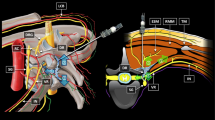Abstract
PURPOSE: The aim of this study was to determine if local injection of bupivacaine after hemorrhoidal banding causes a decrease in pain and in the incidence of associated symptoms. METHODS: After hemorrhoidal banding, patients were randomly assigned to receive a local injection of bupivacaine with 1:200,000 epinephrine, an injection of normal saline, or no injection, just superior to each band. Pain was graded by the patient and by the study nurse within 30 minutes, and any associated symptoms were recorded. At intervals 6, 24, and 48 hours postbanding, the patient recorded pain, limitation of activities, and analgesic requirements. Associated symptoms while at home were recorded. RESULTS: Of 115 patients studied, 42 received bupivacaine injection, 42 received normal saline injection, and 31 received no injection. In patients receiving bupivacaine compared with no injection, within 30 minutes postbanding there was a significant reduction in pain graded by the patient (P=0.000002) and by the nurse (P=0.000005) and a significant reduction in incidence of nausea (P=0.01) and shaking (P=0.008). However, in the bupivacaine group compared with the other two groups, at the intervals of 6, 24, and 48 hours postbanding there was no sustained reduction in the severity of pain and no reduction in analgesic requirements or limitation of normal activities. In the week after banding, there was no difference between groups in symptoms of nausea, shaking, lightheadedness, urinary retention, or bleeding. CONCLUSIONS: Bupivacaine injection may be useful for reducing pain and associated symptoms long enough to tolerate a trip home from the outpatient department but does not show a sustained effect.
Similar content being viewed by others
References
MacRae HM, McLeod RS. Comparison of hemorrhoidal treatment modalities: a meta-analysis. Dis Colon Rectum 1995;38:687–94.
Johanson JF, Rimm A. Optimal nonsurgical treatment of hemorrhoids: a comparative analysis of infrared coagulation, rubber band ligation, and injection sclerotherapy. Am J Gastroenterol 1992;87:1601–6.
Lee HH, Spencer RJ, Beart RW Jr. Multiple hemorrhoidal bandings in a single session. Dis Colon Rectum 1994;37:37–41.
Lau WY, Chow HP, Poon GP, Wong SH. Rubber band ligation of three primary hemorrhoids in a single session—a safe and effective procedure. Dis Colon Rectum 1982;25:336–9.
Hardwick RH, Durdey P. Should rubber band ligation of hemorrhoids be performed at the initial outpatient visit? Ann R Coll Surg Engl 1994;76:185–7.
Tchirkow G, Haas PA, Fox TA Jr. Injection of a local anesthetic solution into hemorrhoidal bundles following rubber band ligation. Dis Colon Rectum 1982;25:62–3.
Barron J. Office ligation of internal hemorrhoids. Am J Surg 1963;105:563.
Williams JA, Evans JC. An assessment of anestheticsteroid suppositories: a controlled trial following rubber-band ligation of hemorrhoids. Dis Colon Rectum 1972;15:66–8.
Author information
Authors and Affiliations
About this article
Cite this article
Hooker, G.D., Plewes, E.A., Rajgopal, C. et al. Local injection of bupivacaine after rubber band ligation of hemorrhoids. Dis Colon Rectum 42, 174–179 (1999). https://doi.org/10.1007/BF02237123
Issue Date:
DOI: https://doi.org/10.1007/BF02237123




